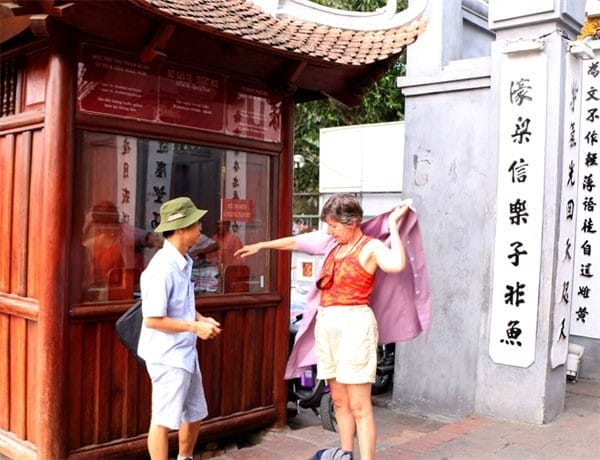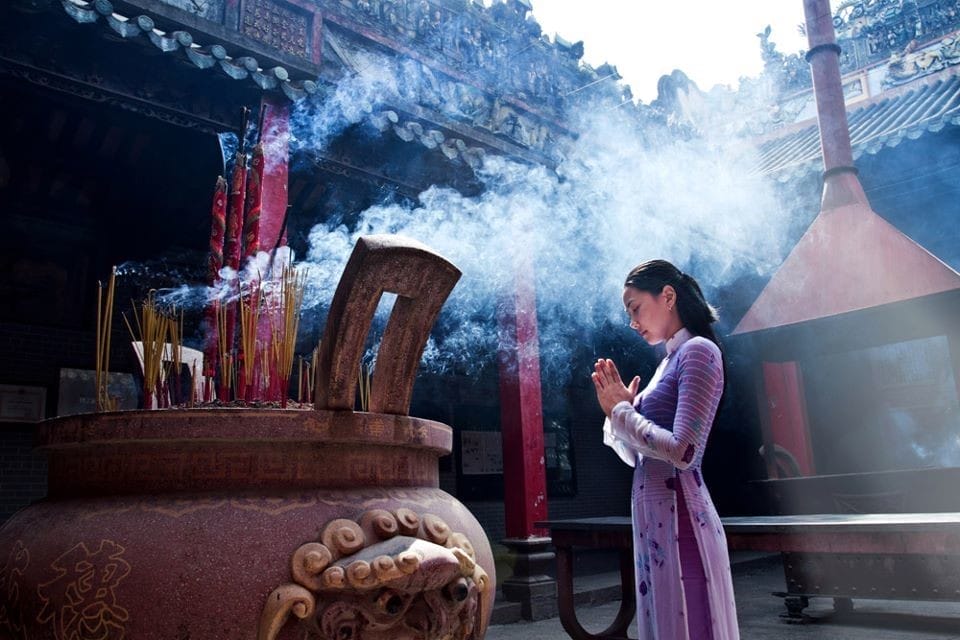With over 18.000 Pagodas all around Vietnam from North to South (according to statistics of the Vietnam Buddhist Sangha) and many of them are considered architectural wonders and ideal locations to explore, visiting a Buddhist Pagoda in Vietnam can be a serene and culturally enriching experience. Whether you’re a traveler seeking to immerse yourself in local traditions or simply curious about Buddhist practices, knowing what to do when visiting a pagoda is really important to enhance your visit.
1. What to Do when visiting the Buddhist Pagoda
Respectful Attire
Out of respect for the chasity of the monks from Pagoda in Vietnam, visitors should wear modest clothing that covers your shoulders and knee.
Men should avoid wearing shorts or muscle shirts. At certain locations, long pants, shoes, or back-strap sandals (without flip-flops) are expected attire.
Women should opt for a skirt or pants that cover the knees. It’s important to note that leggings and tight pants are not permitted. Additionally, tank tops and spaghetti straps are prohibited. Sandals with straps are permitted, but flip-flops are not allowed.

Observe Silence
Inside the serene halls of a Buddhist pagoda, maintaining silence is essential to create a peaceful atmosphere conducive to meditation and prayer.
By observing silence, you show respect for those who are engaged in spiritual practices within the pagoda.
This quiet and respectful demeanor allows visitors to fully immerse themselves in the tranquil ambiance of the pagoda and experience a deeper sense of connection with their surroundings.
Bow and Offer Incense
Upon entering a Buddhist pagoda, it’s customary to perform a gesture of respect towards the main altar.
This often involves bowing respectfully as a symbol of humility and reverence. Additionally, offering incense is a common ritual practice by visitors to purify the surroundings and show devotion to the Buddha and other revered figures.
By participating in these rituals, visitors demonstrate their sincerity and commitment to honoring the spiritual significance of the pagoda.

Following the Rituals:
Buddhist pagodas are often centers of religious ceremonies and rituals conducted by monks and practitioners.
When visiting a pagoda, it’s essential to observe these rituals quietly and respectfully from a distance.
By doing so, visitors can gain insight into the rich spiritual traditions of Buddhism and appreciate the cultural significance of the ceremonies taking place within the pagoda’s sacred spaces.

Be a responsible photographer
Photography in most temples in Vietnam is OK, but it’s important to observe certain rules to avoid any missteps:
- Refrain from taking photos of worshipers;
- Avoid taking selfies with Buddha statues;
- Be mindful not to pass in front of those praying.
Additionally, certain sacred areas within the temple may be off-limits for photography, with signs available in both English and Vietnamese to assist you.
2. What Not to Do when visiting the Buddhist Pagoda
Disrespectful Behavior:
Vietnamese culture places great emphasis on politeness and respect, especially in religious settings like Buddhist pagodas. It’s important to avoid any behavior that may disrespect or disrupt, such as speaking loudly, running, or taking photos without permission. These actions can disrupt the peaceful atmosphere of the pagoda and show a lack of regard for the spiritual significance of the space.
Touching Religious Objects:
When visiting a Buddhist pagoda in Vietnam, it’s crucial to show reverence for religious objects, statues, artifacts, and sacred texts. Refrain from touching or leaning on these items, as they hold deep spiritual significance for practitioners. By respecting these religious objects, visitors demonstrate their understanding of and respect for Buddhist beliefs and traditions.
Pointing Feet:
In Buddhist culture, pointing your feet towards the main altar or any religious images is impolite and disrespectful. When sitting or standing inside the pagoda, be mindful of the direction of your feet and avoid pointing them towards sacred objects or areas. This gesture shows reverence for the Buddha and other revered figures and demonstrates respect for the spiritual significance of the pagoda.
Eating or Drinking:
Consuming food or drinks inside a pagoda is inappropriate and disrespectful in Vietnamese culture. Pagodas are places of worship and meditation, and eating or drinking inside can disrupt the solemn atmosphere and show a lack of reverence for the spiritual significance of the space. Visitors should refrain from bringing food or drinks into the pagoda and instead enjoy refreshments outside the premises.
Intrusive Questions:
While it’s natural to have questions about Buddhism or the practices observed in the pagoda, it’s important to ask them respectfully and considerately. Avoid asking intrusive or personal questions to monks or practitioners, as this will consider as disrespectful. Instead, approach interactions with humility and openness, demonstrating a genuine interest in learning about Buddhist teachings and traditions.
Disrespecting Monks:
Monks play a central role in Buddhist pagodas, serving as spiritual leaders and guides for practitioners. It’s essential to treat monks with the utmost respect and reverence, refraining from interrupting their daily activities or meditation sessions. Avoid approaching monks without invitation and respect their need for solitude and contemplation. By showing respect for monks, visitors honor their dedication to the practice of Buddhism and uphold the sanctity of the pagoda as a place of worship and reflection.
Visiting a Buddhist pagoda in Vietnam offers a unique opportunity to connect with the country’s rich spiritual heritage. By following these simple guidelines of respect and mindfulness, you can fully immerse yourself in the peaceful atmosphere of the pagoda and gain a deeper appreciation for Buddhist culture and traditions.
If you need any further information about Vietnam, don’t hesitate to contact us for more insights into this amazing country!
















